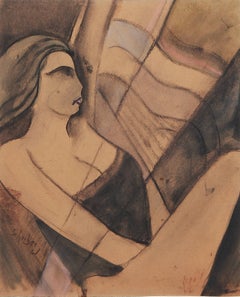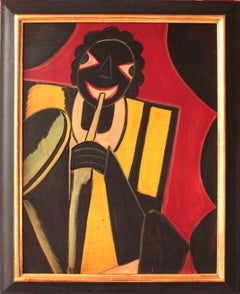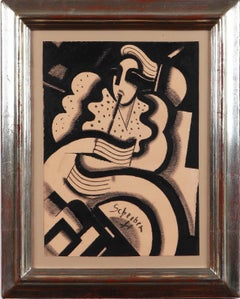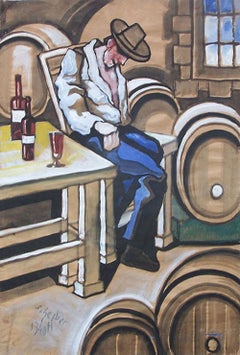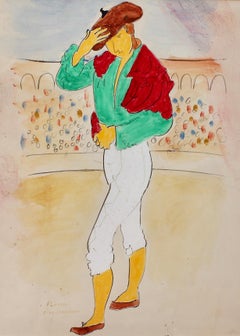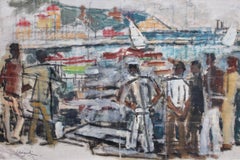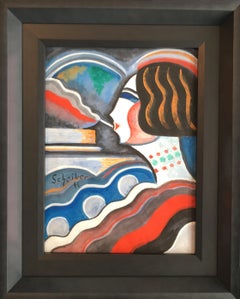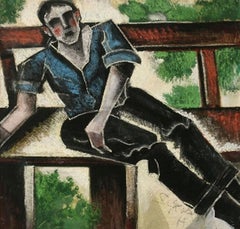Hugó Scheiber Art
to
4
1
5
1
1
Overall Width
to
Overall Height
to
12
5
2
2
3
2
2
11
1
8
5
4
3
1
1
1
1
1
1
1
1
1
8
7
7
5
5
13
7,820
5,167
2,504
1,502
3
10
2
Artist: Hugó Scheiber
Hugó Scheiber Pastel "Sailing", about 1930
By Hugó Scheiber
Located in Berlin, DE
Pastel and carbon pencil on cardboard, ca. 1930 by Hugo Scheiber. Signed lower left: Scheiber H.
Dimensions: 14.96 x 12.99 in ( 38 x 33 cm ), Framed: 19.69 x 15.75 in ( 50 x 40 cm )
...
Category
Early 20th Century Expressionist Hugó Scheiber Art
Materials
Pastel, Cardboard, Carbon Pencil
"Jazz Musician" Oil Painting 1930 by Hugó Scheiber
By Hugó Scheiber
Located in Berlin, DE
Oil on wood, 1930. Signed lower right. Framed. Height 31.10 in ( 79 cm ), Width 25.19 in ( 64 cm )
The Hungarian artist Hugó Scheiber lived 1922-1934 in Berlin, that's where he pain...
Category
1930s Cubist Hugó Scheiber Art
Materials
Oil, Wood Panel
Hugó Scheiber "Portrait of a Woman", 1925
By Hugó Scheiber
Located in Berlin, DE
Pencil, charcoal, ink on paper, 1925 by Hugó Scheiber ( 1873-1950 ), important artist of Hungarian modernity. Signed lower center: Scheiber H. Dimensions: 13.78 x 9.84 in ( 35 x 25 ...
Category
1920s Modern Hugó Scheiber Art
Materials
Mixed Media
Rare Modernist Hungarian Rabbi Pastel Drawing Gouache Painting Judaica Art Deco
By Hugó Scheiber
Located in Surfside, FL
Rabbi in the synagogue at prayer wearing tallit and tefillin.
Hugó Scheiber (born 29 September 1873 in Budapest – died there 7 March 1950) was a Hungarian modernist painter.
Hugo Scheiber was brought from Budapest to Vienna at the age of eight where his father worked as a sign painter for the Prater Theater. At fifteen, he returned with his family to Budapest and began working during the day to help support them and attending painting classes at the School of Design in the evening, where Henrik Papp was one of his teachers. He completed his studies in 1900. His work was at first in a post-Impressionistic style but from 1910 onward showed his increasing interest in German Expressionism and Futurism. This made it of little interest to the conservative Hungarian art establishment.
However, in 1915 he met the great Italian avant-gardist Filippo Tommaso Marinetti and the two painters became close friends. Marinetti invited him to join the Futurist Movement. The uniquely modernist style that he developed was, however, closer to German Expressionism than to Futurism and eventually drifted toward an international art deco manner similar to Erté's. In 1919, he and his friend Béla Kádar held an exhibition at the Hevesy Salon in Vienna. It was a great success and at last caused the Budapest Art Museum to acquire some of Scheiber's drawings. Encouraged, Scheiber came back to live in Vienna in 1920.
A turning point in Scheiber's career came a year later, when Herwarth Walden, founder of Germany's leading avant-garde periodical, Der Sturm, and of the Sturm Gallery in Berlin, became interested in Scheiber's work. Scheiber moved to Berlin in 1922, and his paintings soon appeared regularly in Walden's magazine and elsewhere. Exhibitions of his work followed in London, Rome, La Paz, and New York.
Scheiber's move to Germany coincided with a significant exodus of Hungarian artists to Berlin, including Laszlo Moholy-Nagy and Sandor Bortnyik. There had been a major split in ideology among the Hungarian avant-garde. The Constructivist and leader of the Hungarian avantgarde, Lajos Kassák (painted by Hugó Scheiber in 1930) believed that art should relate to all the needs of contemporary humankind. Thus he refused to compromise the purity of his style to reflect the demands of either the ruling class or socialists and communists. The other camp believed that an artist should be a figurehead for social and political change.
The fall out and factions that resulted from this politicisation resulted in most of the Hungarian avant gardists leaving Vienna for Berlin. Hungarian émigrés made up one of the largest minority groups in the German capital and the influx of their painters had a significant effect on Hungarian and international art. Another turning point of Scheiber's career came in 1926, with the New York exhibition of the Société Anonyme, organized by Katherine Dreier. Scheiber and other important avant garde artists from more than twenty-three countries were represented. In 1933, Scheiber was invited by Marinetti to participate in the great meeting of the Futurists held in Rome in late April 1933, Mostra Nazionale d’Arte Futurista where he was received with great enthusiasm. Gradually, the Hungarian artists began to return home, particularly with the rise of Nazism in Germany. Kádar went back from Berlin in about 1932 and Scheiber followed in 1934.
He was then at the peak of his powers and had a special flair in depicting café and cabaret life in vivid colors, sturdily abstracted forms and spontaneous brush strokes. Scheiber depicted cosmopolitan modern life using stylized shapes and expressive colors. His preferred subjects were cabaret and street scenes, jazz musicians, flappers, and a series of self-portraits (usually with a cigar). his principal media being gouache and oil. He was a member of the prestigious New Society of Artists (KUT—Képzőművészek Új Társasága)and seems to have weathered Hungary's post–World War II transition to state-communism without difficulty. He continued to be well regarded, eventually even receiving the posthumous honor of having one of his images used for a Russian Soviet postage stamp (see image above). Hugó Scheiber died in Budapest in 1950.
Paintings by Hugó Scheiber form part of permanent museum collections in Budapest (Hungarian National Museum), Pecs (Jannus Pannonius Museum), Vienna, New York, Bern and elsewhere. His work has also been shown in many important exhibitions, including:
"The Nell Walden Collection," Kunsthaus Zürich (1945)
"Collection of the Société Anonyme," Yale University Art Gallery, New Haven, Connecticut (1950)
"Hugó Scheiber: A Commemorative Exhibition," Hungarian National Museum, Budapest (1964)
"Ungarische Avantgarde," Galleria del Levante, Munich (1971)
"Paris-Berlin 1900-1930," Centre Georges Pompidou, Paris (1978)
"L’Art en Hongrie, 1905-1920," Musée d’Art et l’Industrie, Saint-Etienne (1980)
"Ungarische Avantgarde in der Weimarer Republik," Marburg (1986)
"Modernizmus," Eresz & Maklary Gallery, Budapest (2006)
"Hugó Scheiber & Béla Kádár," Galerie le Minotaure, Paris and Tel Aviv (2007)
Hugó Scheiber's paintings continue to be regularly sold at Sotheby's, Christie's, Gillen's Arts (London), Papillon Gallery (Los Angeles) and other auction houses.
He was included in the exhibition The Art Of Modern Hungary 1931 and other exhibitions along with Vilmos Novak Aba, Count Julius Batthyany, Pal Bor, Bela Buky, Denes Csanky, Istvan Csok, Bela Czobel, Peter Di Gabor, Bela Ivanyi Grunwald, Baron Ferenc Hatvany, Lipot Herman, Odon Marffy, C. Pal Molnar...
Category
Early 20th Century Modern Hugó Scheiber Art
Materials
Paper, Charcoal, Pastel, Watercolor, Gouache
"Jazz Musician" Oil Painting 1930 by Hugó Scheiber
By Hugó Scheiber
Located in Berlin, DE
Oil on wood, 1930. Signed lower right. Framed. Height 31.10 in ( 79 cm ), Width 25.19 in ( 64 cm )
The Hungarian artist Hugó Scheiber lived 1922-1934 in Berlin, that's where he pain...
Category
1930s Cubist Hugó Scheiber Art
Materials
Oil, Wood Panel
At the Winery - Hungarian Art
By Hugó Scheiber
Located in London, GB
This original painting is hand signed by the artist "Scheiber H" in the lower left corner,
and dated "1940" below the signature.
Exhibited: Hugo Scheiber - Bela Kadar, Galerie Le Mi...
Category
1940s Hugó Scheiber Art
Materials
Tempera, Gouache
"Woman with a Cigarette", Hugo Scheiber (1873-1950)
By Hugó Scheiber
Located in Paris, FR
Hugo Scheiber (1873-1950) was a Hungarian painter of Jewish origins. He started as a self-taught artist. He was initially inspired by Impressionism before evolving towards Expression...
Category
1920s Expressionist Hugó Scheiber Art
Materials
Gouache, Cardboard
Hugó Scheiber Theater Scene with a Dancer, Gouache ca. 1920
By Hugó Scheiber
Located in Berlin, DE
Gouache on paper, 1920's by Hugò Scheiber ( 1873-1950 ) Hungary. Signed with pencil lower central: Scheiber H.
Framed under glass. Height: 25.98 in ( 66 cm ), Width: 19.69 in ( 50 c...
Category
1920s Expressionist Hugó Scheiber Art
Materials
Gouache, Paper
Landscape with Tree and Houses
By Hugó Scheiber
Located in London, GB
HUGO SCHEIBER 1873-1950
1873 - Budapest-1950 (Hungarian)
Title: Landscape with Tree and Houses, circa 1930's
Technique: Signed Gouache and Pastel Painting on Paper
Size: 67.5 x 48...
Category
1930s Art Deco Hugó Scheiber Art
Materials
Pastel, Gouache
Hugó Scheiber Pastel "Sailing", about 1930
By Hugó Scheiber
Located in Berlin, DE
Pastel and carbon pencil on cardboard, ca. 1930 by Hugo Scheiber. Signed lower left: Scheiber H.
Dimensions: 14.96 x 12.99 in ( 38 x 33 cm ), Framed: 19.69 x 15.75 in ( 50 x 40 cm )
...
Category
Early 20th Century Expressionist Hugó Scheiber Art
Materials
Pastel, Cardboard, Carbon Pencil
Hugó Scheiber "Portrait of a Woman", 1925
By Hugó Scheiber
Located in Berlin, DE
Pencil, charcoal, ink on paper, 1925 by Hugó Scheiber ( 1873-1950 ), important artist of Hungarian modernity. Signed lower center: Scheiber H. Dimensions: 13.78 x 9.84 in ( 35 x 25 ...
Category
1920s Modern Hugó Scheiber Art
Materials
Mixed Media
Deco Dancing Hungarian Expressionism European Drawing Modernism Figurative Dance
By Hugó Scheiber
Located in New York, NY
Deco Dancing Hungarian Expressionism European Drawing Modernism Figurative Dance. 22 1/2 x 16 inches. Signed lower left. Framed.
BIO
Hugó Scheiber was born in Budapest in 1873. At the age of eight, he moved with his family from Budapest to Vienna.
In 1898, to help support his family after they had returned to Budapest. He started working during the day, attending painting classes at the Commercial Art School in the evening. In 1900, he completed his studies.
Scheiber showed an early interest in German Expressionism and Futurism. In 1915 he met Marinetti, who invited him to join the Futurist movement. Because Scheiber's paintings conflicted with academic style of the Hungarian art establishment, his work was virtually ignored in his own country. In 1919, he and his friend Béla Kádár held an exhibition organized by Hévesy in Vienna, which was a great success, so much so that the Budapest Art Museum purchased two of his drawings.
In 1920, Scheiber returned to Vienna. A turning point in his career came in 1921 when Herwarth Walden, founder of Germany's leading avant-garde periodical, Der Sturm...
Category
1920s Art Deco Hugó Scheiber Art
Materials
Paper, Gouache
The Rhythm of the City - Hungarian Art Futurism Cubism
By Hugó Scheiber
Located in London, GB
HUGO SCHEIBER 1873-1950
1873 - Budapest - 1950 (Hungarian)
Title: The Rhythm of the City, 1920's/1930's
Technique: Original Signed Charcoal and Pastel Drawing on Paper
Size: 61 x ...
Category
1920s Cubist Hugó Scheiber Art
Materials
Charcoal, Pastel
Self Portrait
By Hugó Scheiber
Located in London, GB
HUGO SCHEIBER 1873-1950
1873 - Budapest - 1950 (Hungarian)
Title: Self Portrait
Technique: Original Signed Pastel Drawing on Paper
Size: 37.7 x 30 cm. / 14.8 x 11.8 in.
Additiona...
Category
1940s Futurist Hugó Scheiber Art
Materials
Pastel
The Rest
By Hugó Scheiber
Located in London, GB
HUGO SCHEIBER 1873-1950
1873 - Budapest - 1950 (Hungarian)
Title: The Rest
Technique: Signed Gouache Painting on Brown Paper
Size: 35.5 x 49 cm. / 14.8 x 1...
Category
20th Century Hugó Scheiber Art
Materials
Gouache
Related Items
La Montera
By Pierre Ambrogiani
Located in London, GB
'La Montera', gouache, watercolour and ink on art paper, by Pierre Ambrogiani (circa 1960s). The artist created many artworks with bullfighting as theme. In this case, a single torer...
Category
1960s Expressionist Hugó Scheiber Art
Materials
Paper, Watercolor, Gouache
Sailors in the Port of Nice
By Alfred Salvignol
Located in London, GB
'Sailors in the Port of Nice', mixed media - gouache, pastel and oil on paper, by Alfred Salvignol (circa 1950s). The Port of Nice is one of the key hubs of Nice and, in fact, of the entire French Riviera, standing out as one of the main harbours for the boats which sail across the Mediterranean Sea. It accommodates both the ships operated by ferry companies and the private yachts of visitors who come to Nice by sea. The artist here depicts a group of crusty sailors watching...
Category
1950s Expressionist Hugó Scheiber Art
Materials
Paper, Pastel, Oil, Gouache
Portrait of Vincent Van Gogh with Bandaged Ear and Pipe.
By (After) Vincent van Gogh
Located in Cotignac, FR
Gouache and watercolour on corrugated cardboard after the famous self portrait by Vincent van Gogh with his fur hat, bandaged ear and pipe. This painting is by Jean Ducel who has pla...
Category
Late 20th Century Hugó Scheiber Art
Materials
Watercolor, Gouache, Cardboard
Modern Dancers
By Mick Micheyl
Located in London, GB
'Modern Dancers', pastel, ink and gouache on fine art paper by French artist, singer and sculptor, Mick Micheyl (1964). Two elegant young men are depicted in a graceful dancing pose, arms outstretched, their lithe bodies so agile and limber. Perhaps one of the dancers was her friend, Philippe, to whom the painting is dedicated on the bottom. The dedication says: 'For you Philippe, all my friendship'. Signed: 'Mick Micheyl'. The work has been newly framed and glazed after having been acquired in the S. of France. It is in fair vintage condition commensurate with age showing minor blemishing on the paper. Upon request a video of the piece can be provided.
Dimensions with Frame:
H 75 cm / 29.5"
W 61 cm / 24"
Dimensions without Frame:
H 56 cm / 22"
W 42 cm / 16.5"
About the Artist: Mick Micheyl (1922 - 2019) was born in Lyon and had a busy and rewarding artistic career as a singer, producer, reviewer, metal sculptor, artist. After having received training at the School of Fine Arts in Lyon she became a painter and decorator in the theatre but then commenced a career in the musical activities of a theatrical troupe. She won the ABC competition in Paris in 1949 with a song, Le Marchand de Poésie, which she composed herself. She then performed in many cabarets: L'Échelle de Jacob, Harlequin and Liberty's. In the 1950s she was one of the most important French cabaret singers of that period. One of her titles, 'Un Gamin de Paris', became one of the French standards and also performed by Yves Montand and Robert Clary...
Category
1960s Modern Hugó Scheiber Art
Materials
Paper, Pastel, Ink, Gouache
'The Lamoille Project #63' original monoprint signed by Mickey Myers
Located in Milwaukee, WI
Mickey Myers is perhaps best known for her Pop art designs from the 1970s and '80s, where she would make vibrant compositions of Crayola crayons. In her l...
Category
2010s Contemporary Hugó Scheiber Art
Materials
Pastel, Monoprint
Mediterranean Seascape, Nautical Cyanotype on Watercolor Paper, Blueprint
By Kind of Cyan
Located in Barcelona, ES
This is an exclusive handprinted limited edition cyanotype.
"Mediterranean Blue Sea Waves" is a handmade cyanotype print of the subtle tidal flow moving in on the Mediterranean Sea.
...
Category
2010s Realist Hugó Scheiber Art
Materials
Emulsion, Watercolor, Rag Paper, Lithograph
Rare Hand Colored "Cabane Des Hold" - 1st Ed "Description de l’Univers" C. 1683
By Alain Manesson Mallet
Located in Soquel, CA
Rare Engraving "Cabane Des Hold, Terres Artiques, Fig CII," 1st edition "Description de l’Univers, page 281
This rare image depicts the Willem Barentsz expedition of 1597 to Novaya Zemlya, Russia. The engraving, with later hand-coloring, shows the cabin and ship of the Dutch arctic expedition of Barentsz on Novaya Zemlya (Nova Zembla), with the party being attacked (and in some cases apparently eaten) by bears and wolves. Dutch explorer, Willem Barentsz, reached the west coast of Novaya Zemlya in 1594, and in a subsequent expedition of 1596 rounded the northern point and wintered on the northeast coast. Barentsz died during the expedition, and may have been buried on the northern island.
This artwork is a page from a book by 17th century cartographer and engineer, Allain Manesson Mallet (French, 1630-1706), "Description de L'Univers, contenant les differents systêmes du monde, les cartes générals et particulières de la géographie ancienne et modern." Paris: Denys Thierry, 1683.
Presented in an cream colored mat.
Text on verso shown in images.
Mat Size: 11.5"H x 9.07"W
Paper Size: 8.25"H x 5.44"W
Image Size: 5.63"H x 3.75"W
Alain Manesson Mallet (French, 1630-1706) was a 17th century cartographer and military engineer. He started his career as a musketeer in the army of Louis XIV, became a Sergeant-Major in the artillery and an Inspector of Fortifications. He later served under Alfonso VI, King of Portugal...
Category
1680s Realist Hugó Scheiber Art
Materials
Paper, Ink, Gouache
H 11.5 in W 9.07 in D 0.07 in
The South West Prospect of London – English School 18th century
Located in Middletown, NY
A stunning 18th century optical view of London from the Thames.
London: 1760.
Copper plate engraving with hand coloring in watercolor on cream laid paper with a large circular wate...
Category
Mid-18th Century English School Hugó Scheiber Art
Materials
Watercolor, Handmade Paper, Engraving
Chinatown, San Francisco
By Edward Wilson Currier
Located in London, GB
'Chinatown, San Francisco', gouache on fine art paper, by Edward Wilson Currier (1903). Spofford Alley in San Francisco's Chinatown is best known for an address (number 36) where Dr. Sun Yat-Sen plotted the overthrow of China's last dynasty. During Prohibition, it was the site of turf battles over local bootlegging and protection rackets. Today it is lined with seniors' community centres. However, the quiet alley livens up in the evenings when a Chinese orchestra strikes up a tune, mah-jongg games begin with a cascade of clicking tiles, and barbers and florists use the pretence of sweeping their doorsteps to gossip. In this artist's depiction, a man smokes a long-stemmed Chinese pipe under the awning and colourful lanterns hanging from the wooden supports while a child looks on. The artwork is interesting from several standpoints including architectural, cultural and historical. Shortly after this work was painted, the neighbourhood was completely destroyed in the 1906 earthquake that levelled most of the city. From 1910 to 1940, Chinese immigrants were detained at the Angel Island...
Category
Early 1900s Expressionist Hugó Scheiber Art
Materials
Paper, Gouache
“Tending the Sheep”
By Myles Birket Foster
Located in Southampton, NY
Beautifully executed original hand colored lithograph using gouache and watercolor. Scene in Surrey, England. Signedxwith monogram in plate lower left, Myles Birket Foster. Published by M. H. Long. Condition is very good. In original 2 inch wide birdseye maple antique frame with thick museum mat with gold innner edge. Overall 22 by 26 inches.
Biography
Myles Birket Foster (4 February 1825 – 27 March 1899) was a popular English illustrator, watercolour artist and engraver in the Victorian period. His name is also to be found as Myles Birkett Foster.
Life and work
Foster was born in North Shields, England of a primarily Quaker family, but his family moved south to London in 1830, where his father founded M. B. Foster & sons — a successful beer-bottling company. He was schooled at Hitchin, Hertfordshire and on leaving initially went into his father's business. However, noticing his talent for art, his father secured an apprenticeship with the notable wood engraver, Ebenezer Landells, where he worked on illustrations for Punch magazine and the Illustrated London News.
On leaving Landells' employ, he continued to produce work for the Illustrated London News and the Illustrated London Almanack. He also found work as a book illustrator and, during the 1850s, trained himself to paint in watercolours. His illustrations of Longfellow’s Evangeline and books of poetry by other contemporaries were a great success, and he quickly became a successful artist in watercolours. Birket Foster became an Associate of the "Old" Watercolour Society (Later the Royal Watercolour Society) in 1860 and exhibited some 400 of his paintings at the Royal Academy over more than 2 decades.
Birket Foster travelled widely, painting the countryside around Scotland, the Rhine Valley, the Swiss lakes and in Italy, especially Venice. In 1863 he moved to Witley, near Godalming in Surrey where he had a house ("The Hill") built. Being friendly with Edward Burne-Jones and William Morris, he had the house decorated and furnished in contemporary style, with tiles and paintings by Burne-Jones and Morris' firm, Morris and Company. The same year he published a volume of "English Landscapes," with text by Tom Taylor...
Category
1880s Impressionist Hugó Scheiber Art
Materials
Lithograph, Watercolor, Gouache
Sacré-Coeur Montmartre at Willette Square Paris
By Lucien Génin
Located in London, GB
'Sacré-Coeur, Montmartre at Willette Square, Paris', gouache on art paper (circa 1930s), by Lucien Génin. Created by the Director of Public Ways and Promenades under Napoleon III, Sq...
Category
1930s Expressionist Hugó Scheiber Art
Materials
Paper, Gouache
Davis F. Schwartz "Historic First Theater, Monterey County" PRINT c.1950
Located in San Francisco, CA
Davis Francis Schwartz "Historic First Theater, Monterey County" Original PRINT C.1950
PRINT dimensions 20" wide x 16" high
The distressed per...
Category
Mid-20th Century Impressionist Hugó Scheiber Art
Materials
Watercolor
Previously Available Items
Untitled image of woman smoking by modernist painter Hugó Scheiber
By Hugó Scheiber
Located in Hudson, NY
This artwork is framed with non-reflective, UV protection Museum glass. The frame size is 15.5" x 12.75"
About this artist: Hugó Scheiber was born in Budapest, Hungary in 1873. His ...
Category
Early 20th Century Modern Hugó Scheiber Art
Materials
Paper, Tempera, Gouache
"Man on a Bench" Hungarian Futurist, Expressionist, Figurative Portrait Modern
By Hugó Scheiber
Located in New York, NY
"Man on a Bench" Hungarian Futurist, Expressionist, Figurative Portrait Modern. Signed lower right
Scheiber is considered one of Hungary’s great modernists.
Scheiber showed an earl...
Category
1920s Modern Hugó Scheiber Art
Materials
Paper, Mixed Media
Rare Modernist Hungarian Rabbi Pastel Drawing Gouache Painting Judaica Art Deco
By Hugó Scheiber
Located in Surfside, FL
Rabbi in the synagogue at prayer wearing tallit and tefillin.
Hugó Scheiber (born 29 September 1873 in Budapest – died there 7 March 1950) was a Hungarian modernist painter.
Hugo Scheiber was brought from Budapest to Vienna at the age of eight where his father worked as a sign painter for the Prater Theater. At fifteen, he returned with his family to Budapest and began working during the day to help support them and attending painting classes at the School of Design in the evening, where Henrik Papp was one of his teachers. He completed his studies in 1900. His work was at first in a post-Impressionistic style but from 1910 onward showed his increasing interest in German Expressionism and Futurism. This made it of little interest to the conservative Hungarian art establishment.
However, in 1915 he met the great Italian avant-gardist Filippo Tommaso Marinetti and the two painters became close friends. Marinetti invited him to join the Futurist Movement. The uniquely modernist style that he developed was, however, closer to German Expressionism than to Futurism and eventually drifted toward an international art deco manner similar to Erté's. In 1919, he and his friend Béla Kádar held an exhibition at the Hevesy Salon in Vienna. It was a great success and at last caused the Budapest Art Museum to acquire some of Scheiber's drawings. Encouraged, Scheiber came back to live in Vienna in 1920.
A turning point in Scheiber's career came a year later, when Herwarth Walden, founder of Germany's leading avant-garde periodical, Der Sturm, and of the Sturm Gallery in Berlin, became interested in Scheiber's work. Scheiber moved to Berlin in 1922, and his paintings soon appeared regularly in Walden's magazine and elsewhere. Exhibitions of his work followed in London, Rome, La Paz, and New York.
Scheiber's move to Germany coincided with a significant exodus of Hungarian artists to Berlin, including Laszlo Moholy-Nagy and Sandor Bortnyik. There had been a major split in ideology among the Hungarian avant-garde. The Constructivist and leader of the Hungarian avantgarde, Lajos Kassák (painted by Hugó Scheiber in 1930) believed that art should relate to all the needs of contemporary humankind. Thus he refused to compromise the purity of his style to reflect the demands of either the ruling class or socialists and communists. The other camp believed that an artist should be a figurehead for social and political change.
The fall out and factions that resulted from this politicisation resulted in most of the Hungarian avant gardists leaving Vienna for Berlin. Hungarian émigrés made up one of the largest minority groups in the German capital and the influx of their painters had a significant effect on Hungarian and international art. Another turning point of Scheiber's career came in 1926, with the New York exhibition of the Société Anonyme, organized by Katherine Dreier. Scheiber and other important avant garde artists from more than twenty-three countries were represented. In 1933, Scheiber was invited by Marinetti to participate in the great meeting of the Futurists held in Rome in late April 1933, Mostra Nazionale d’Arte Futurista where he was received with great enthusiasm. Gradually, the Hungarian artists began to return home, particularly with the rise of Nazism in Germany. Kádar went back from Berlin in about 1932 and Scheiber followed in 1934.
He was then at the peak of his powers and had a special flair in depicting café and cabaret life in vivid colors, sturdily abstracted forms and spontaneous brush strokes. Scheiber depicted cosmopolitan modern life using stylized shapes and expressive colors. His preferred subjects were cabaret and street scenes, jazz musicians, flappers, and a series of self-portraits (usually with a cigar). his principal media being gouache and oil. He was a member of the prestigious New Society of Artists (KUT—Képzőművészek Új Társasága)and seems to have weathered Hungary's post–World War II transition to state-communism without difficulty. He continued to be well regarded, eventually even receiving the posthumous honor of having one of his images used for a Russian Soviet postage stamp (see image above). Hugó Scheiber died in Budapest in 1950.
Paintings by Hugó Scheiber form part of permanent museum collections in Budapest (Hungarian National Museum), Pecs (Jannus Pannonius Museum), Vienna, New York, Bern and elsewhere. His work has also been shown in many important exhibitions, including:
"The Nell Walden Collection," Kunsthaus Zürich (1945)
"Collection of the Société Anonyme," Yale University Art Gallery, New Haven, Connecticut (1950)
"Hugó Scheiber: A Commemorative Exhibition," Hungarian National Museum, Budapest (1964)
"Ungarische Avantgarde," Galleria del Levante, Munich (1971)
"Paris-Berlin 1900-1930," Centre Georges Pompidou, Paris (1978)
"L’Art en Hongrie, 1905-1920," Musée d’Art et l’Industrie, Saint-Etienne (1980)
"Ungarische Avantgarde in der Weimarer Republik," Marburg (1986)
"Modernizmus," Eresz & Maklary Gallery, Budapest (2006)
"Hugó Scheiber & Béla Kádár," Galerie le Minotaure, Paris and Tel Aviv (2007)
Hugó Scheiber's paintings continue to be regularly sold at Sotheby's, Christie's, Gillen's Arts (London), Papillon Gallery (Los Angeles) and other auction houses.
He was included in the exhibition The Art Of Modern Hungary 1931 and other exhibitions along with Vilmos Novak Aba, Count Julius Batthyany, Pal Bor, Bela Buky, Denes Csanky, Istvan Csok, Bela Czobel, Peter Di Gabor, Bela Ivanyi Grunwald, Baron Ferenc Hatvany, Lipot Herman, Odon Marffy, C. Pal Molnar...
Category
Early 20th Century Modern Hugó Scheiber Art
Materials
Paper, Pastel, Watercolor, Gouache, Charcoal
Hugó Scheiber art for sale on 1stDibs.
Find a wide variety of authentic Hugó Scheiber art available for sale on 1stDibs. You can also browse by medium to find art by Hugó Scheiber in paint, gouache, watercolor and more. Much of the original work by this artist or collective was created during the 20th century and is mostly associated with the modern style. Not every interior allows for large Hugó Scheiber art, so small editions measuring 8 inches across are available. Customers who are interested in this artist might also find the work of Alexander Raymond Katz, Béla Kádár, and Albert Bertalan. Hugó Scheiber art prices can differ depending upon medium, time period and other attributes. On 1stDibs, the price for these items starts at $5,500 and tops out at $28,076, while the average work can sell for $9,929.
